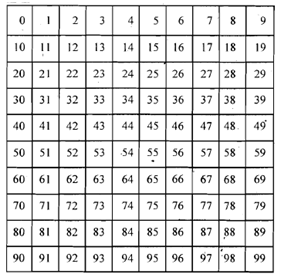E 1) Try the two activities detailed above with a few children around you
Evaluate whether they really helped to improve the children's performance of mental arithmetic.
Another activity which may help children to move from concrete materials towards an abstract understanding of HTO is playing with the number chart.
There are several kinds of activities possible with this chart. For example, a child can be asked to select any number in the chart. Then she could find out whether the number is larger than or smaller than the number just above/below it. After this she could be asked to subtract the smaller number from the larger one and find the difference between them.
From the chosen number, the child can be asked to find out how much the numbers in all these directions differ from the selected number. She can, further, be asked to discover patterns like in which defection the numbers
Increase/decrease, in which direction the difference is in tens and why, etc.

Call we use this chart to help children understand carry-over and borrowing?
Rani's example may help you answer this question.
7-year-old Rani, who was working with the number chart, was given the task of adding 3 7 and 26. She first located 3 7 in the chart, and then wondered what to do next. To help her, the teacher asked her ifshe could break up 26 into two numbers.
Yes', 13 and 13 ", said Rani.
"OK, now break up 13, " said the teacher.
'flOand3".
"So if 13 is I0 plus 3, in the same way what is 26?"
"20 plus 6': she said, after a pause.
"OK, so you have 37, and you want to add 26. So, can you do it by first adding20, and then adding 6.7", the teacher asked. She agreed.
"So how do you move to a number that is 26 larger than 37?"
She moved downwards by 2 squares, and then to the ri-g ht b-y 6. It was while moving rightwards, when she reached the edge and had to move down and
Leftward to the other edge, that she began to understand the meaning of carry- over In this context. From 57 she went right till she came to 59 and then went to 60, situated on the left edge of the next row, and then counted on to 63.
What Rani was really learning was how to split numbers into tens and ones and add, so as to understand what is involved in caring is splitting should be introduced to children through groups of objects first, as discussed in above example. Gradually they can move towards adding two-digit numbers, writing their in tens and ones. For example,
34 + 3 tens and 4 ones 1+28 + 2 tens and 8 ones
5 tens and 12 ones
= 5 tens and 1 ten and 2 ones
= 6 tens and 2 ones
= 62